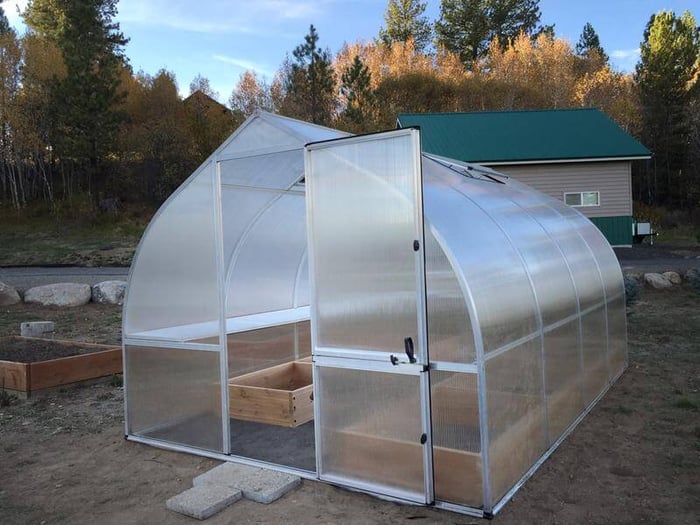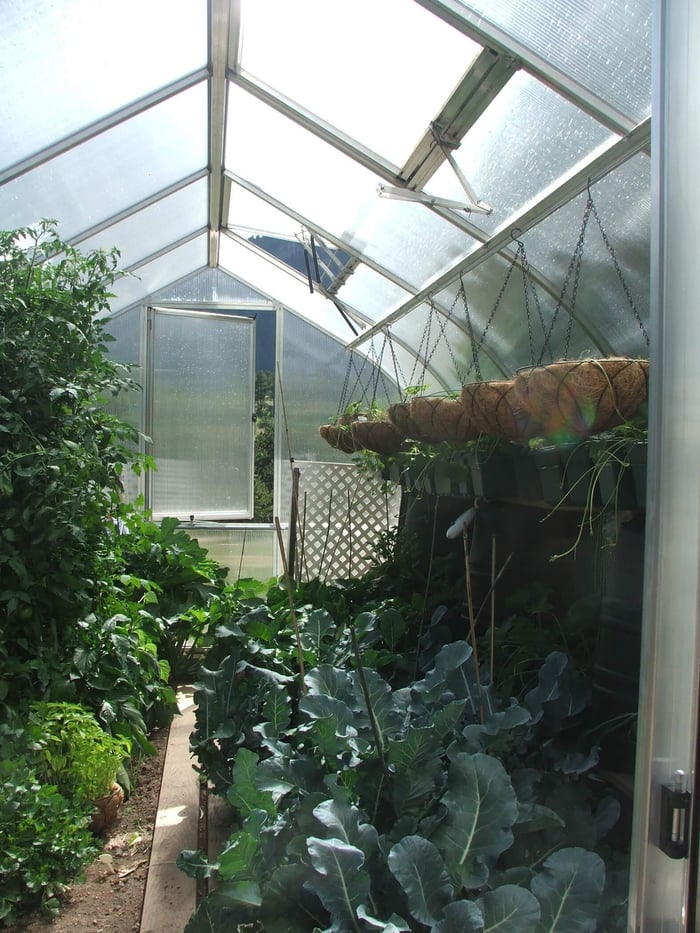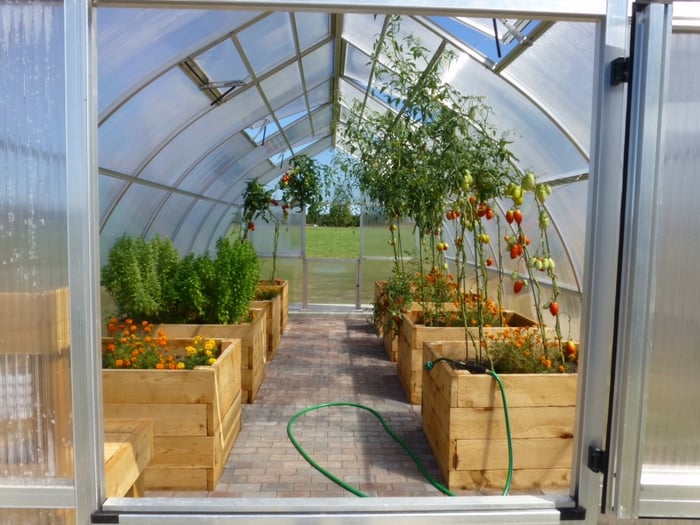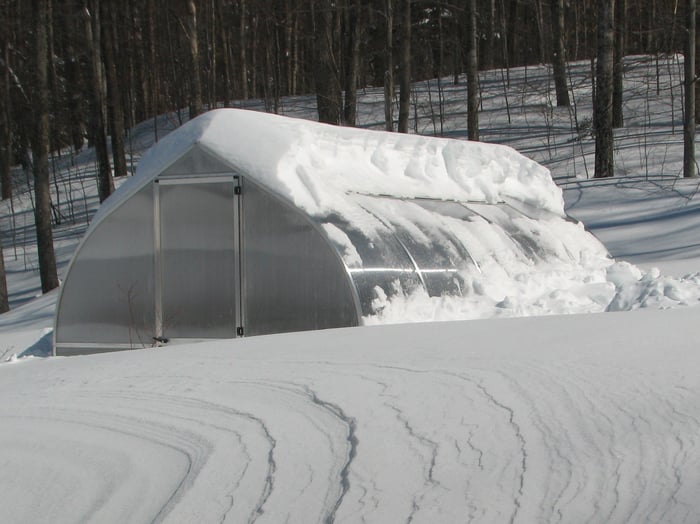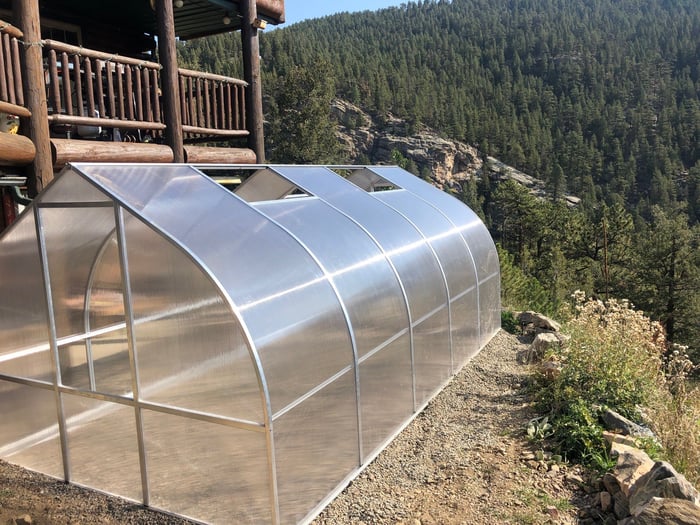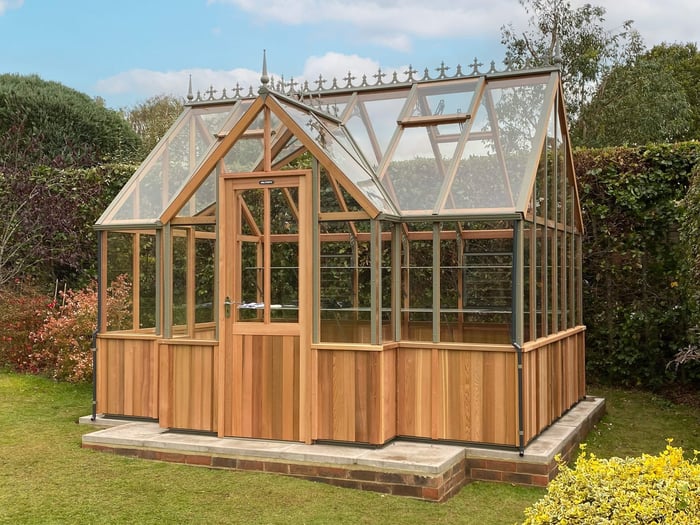Table of Contents
- Colorado's Climate: Beautiful but Brutal for Gardeners
- Why Colorado Challenges Even Experienced Gardeners
- The Greenhouse Advantage in Colorado
- What Makes the Best Greenhouse for Colorado?
- RIGA Greenhouses: The Best Greenhouse for Colorado from South Table Sheds
- Maximizing Your Colorado Greenhouse Results
- Valuable Resources for Colorado Greenhouse Enthusiasts
- Finding Your Best Greenhouse for Colorado
- Ready to Invest in the Best Greenhouse for Colorado?
- FAQs
Best Greenhouse for Colorado: Your Complete Guide to Year-Round Growing
When you stand beneath the towering red sandstone formations at Red Rocks Amphitheatre or look out over the stunning Maroon Bells reflecting in Maroon Lake, Colorado's natural beauty takes your breath away. But that same dramatic landscape comes with gardening challenges that can be equally breathtaking—in a less pleasant way. The key to thriving gardens in the Centennial State? Finding the best greenhouse for Colorado that's built to handle everything our state throws at it.
Colorado's Climate: Beautiful but Brutal for Gardeners
Colorado's environment presents a unique set of obstacles for anyone trying to grow plants. The state's elevation creates conditions you won't find in lower-altitude locations. For every thousand feet you climb above sea level, temperatures drop by approximately 3.5 degrees Fahrenheit. Whether you're gardening in Boulder's lower elevations or trying to grow vegetables in a mountain town, altitude affects everything from water evaporation to frost timing.
The Denver metro area typically sees its final spring frost around mid-May, with the first autumn freeze arriving by mid-October. That gives gardeners roughly 150 to 160 frost-free days—a narrow window compared to many other states. Higher elevation communities face even tighter constraints, with some mountain areas experiencing frost-free periods as brief as five weeks during the entire year.
USDA hardiness zones across Colorado range from zone 3 in the coldest mountain regions to zone 7 in protected valleys. This enormous variation means a gardening technique that works perfectly in Grand Junction might fail completely in Leadville.
Why Colorado Challenges Even Experienced Gardeners
The short growing season represents just one hurdle among many that Colorado gardeners must overcome:
Relentless Sunshine with Consequences: Colorado boasts over 300 sunny days annually, but at high elevation, those rays pack extra punch. Ultraviolet radiation intensifies as altitude increases, potentially causing leaf damage and plant stress that gardeners at sea level never encounter.
Wild Temperature Fluctuations: A pleasant spring afternoon at 70 degrees can crash to freezing by midnight. These radical shifts happen throughout the growing season, stressing plants and damaging tender growth even when frost dates suggest safety.
Desert-Dry Air: Moisture evaporates rapidly in Colorado's arid climate. Plants and soil lose water constantly, creating an ongoing battle to maintain adequate hydration levels, particularly during winter months when humidity plummets further.
Weather That Breaks All Rules: May snowstorms surprise no one here. Neither do February warm spells followed by March blizzards. Colorado's weather patterns defy prediction, making outdoor growing feel like gambling with your harvest.
Hungry Wildlife Everywhere: From deer wandering through Garden of the Gods to elk grazing near Rocky Mountain National Park, Colorado's animals view gardens as all-you-can-eat buffets. Bears, rabbits, and countless other creatures add to the challenge of protecting your plants.
Destructive Hail Events: Colorado experiences some of America's most devastating hailstorms. A single storm can obliterate months of careful gardening work in mere minutes.
The Greenhouse Advantage in Colorado
A well-designed greenhouse directly addresses every challenge listed above:
Stretching the Season: Quality greenhouses add valuable weeks or months to both spring and fall growing periods. Begin planting seedlings in March rather than waiting until May. Harvest fresh lettuce and herbs through Thanksgiving or beyond. Some Colorado greenhouse enthusiasts successfully garden all twelve months.
Smoothing Temperature Extremes: Enclosed greenhouse spaces trap daytime warmth and release it gradually through cold nights. This buffering effect protects plants from the temperature roller coaster happening outside your greenhouse walls.
Maintaining Moisture: Greenhouses naturally hold humidity at higher levels than Colorado's outdoor environment. Plants experience less water stress, and you'll spend less time running irrigation lines.
Shielding from Destruction: Hail bounces harmlessly off sturdy greenhouse panels. Wind can't snap stems. Late-season snow won't flatten your tomato plants. Whether you're growing near Mount Evans or anywhere else along the Front Range, your plants stay safe inside.
Keeping Animals Out: Solid greenhouse construction creates a barrier between your vegetables and every hungry creature roaming Colorado's landscape. No more protective fencing or repellent sprays.
Creating Your Ideal Environment: Control every variable—ventilation, shade, water, temperature—to create perfect growing conditions regardless of weather happening just beyond your greenhouse door, whether that's near the Continental Divide or anywhere else in the state.
What Makes the Best Greenhouse for Colorado?
Not all greenhouses can handle Colorado's demanding conditions. When searching for the best greenhouse for Colorado, you need specific features that address our unique climate challenges:
Built Like a Tank: The best greenhouse for Colorado must handle significant snow accumulation and powerful wind gusts. Look for substantial framing materials and secure anchoring methods. Premium models withstand winds exceeding 115 mph and heavy snow loads that would crush inferior structures.
Insulation Matters: Double-wall panels or insulated construction maintain stable internal temperatures despite frigid nights and prevent overheating during intense sunny periods.
Smart Ventilation Design: Adjustable vents and windows allow you to release excess heat on warm days while retaining warmth when temperatures drop. Proper airflow prevents disease and keeps plants healthy.
Glazing That Handles UV: Polycarbonate panels or quality glass must filter harsh ultraviolet rays while transmitting the beneficial light spectrum plants need for photosynthesis.
Solid Foundations: Proper foundation work prevents frost heave damage and ensures your greenhouse remains level and secure through seasonal freeze-thaw cycles and severe weather events.
Appropriate Sizing: Bigger doesn't always mean better. Right-sized greenhouses are easier to heat during winter and simpler to manage year-round. Match your greenhouse dimensions to your actual needs and maintenance capacity.
RIGA Greenhouses: The Best Greenhouse for Colorado from South Table Sheds
When evaluating options for the best greenhouse for Colorado, South Table Sheds offers RIGA greenhouses—structures specifically suited to our state's demanding conditions. These European-designed greenhouses combine engineering excellence with practical features addressing Colorado's unique challenges.
RIGA construction utilizes heavy-duty aluminum framing that maintains structural integrity under substantial snow weight. Polycarbonate panel systems provide superior insulation compared to single-pane glass while offering excellent UV protection. Thoughtful ventilation designs make temperature regulation straightforward even during Colorado's notorious temperature swings.
The modular RIGA system allows customization matching your specific property needs. Whether you're establishing a growing space in Golden near South Table Mountain, developing a larger garden operation in Castle Rock, or creating a high-altitude greenhouse in Breckenridge, RIGA configurations adapt to your requirements. This flexibility makes RIGA greenhouses a top contender for the best greenhouse for Colorado, regardless of your location or growing goals.
Exaco RIGA Large Polycarbonate Greenhouse
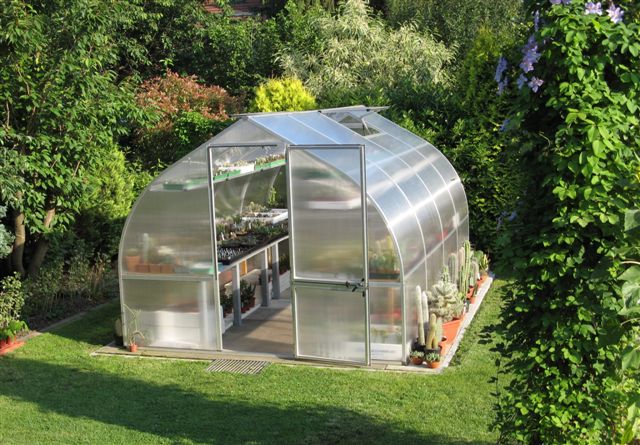
$6,899.00
Best Large Polycarbonate Greenhouse for Cold Climates Sold by South Table Sheds Free Shipping (lower 48 states) No tax Authorized Retailer The RIGA Large Polycarbonate Greenhouse is more than a structure. It’s a sanctuary for gardeners who refuse to be… read more
Maximizing Your Colorado Greenhouse Results
Selecting the best greenhouse for Colorado represents just the first step. These practices help ensure success:
Select Appropriate Varieties: Choose vegetable and plant varieties bred for shorter growing windows and temperature variation tolerance. Colorado State University Extension publishes excellent variety recommendations for our climate.
Incorporate Thermal Mass: Place water-filled barrels or stone features inside your greenhouse. These materials absorb daytime heat and release it gradually overnight, naturally moderating temperature fluctuations.
Deploy Shade Cloth Strategically: Even protected inside greenhouses, Colorado's summer sun intensity can overwhelm plants. Removable shade cloth prevents overheating during peak summer weeks.
Watch Conditions Closely: Temperature changes happen rapidly here. Min-max thermometers help you track daily extremes so you can fine-tune ventilation and heating strategies.
Automate Watering: Drip irrigation or automatic watering systems help maintain consistent moisture. Colorado's low humidity means greenhouse plants consume water quickly, especially during summer.
Begin Modestly: New to greenhouse growing in Colorado? Start with a smaller structure or simple cold frame to learn the basics before investing in larger, more complex systems.
Valuable Resources for Colorado Greenhouse Enthusiasts
These trusted organizations provide Colorado-specific greenhouse guidance:
Colorado State University Extension (extension.colostate.edu): Research-backed information covering greenhouse operations, vegetable variety selection, and season extension strategies specifically developed for Colorado conditions.
Denver Urban Gardens (dug.org): Practical planting schedules and frost date data for Front Range communities, plus connections to local gardening expertise.
The Old Farmer's Almanac (almanac.com): ZIP code-based frost date tools and seasonal planning resources helpful for timing greenhouse planting schedules.
County Extension Offices: Your local Extension office delivers personalized advice matching your specific elevation and microclimate conditions. This free resource proves invaluable for troubleshooting problems and planning strategies.
Finding Your Best Greenhouse for Colorado
Colorado gardeners from the eastern plains to the highest mountain valleys share a common goal: producing fresh homegrown food despite our challenging climate. The best greenhouse for Colorado matches your location, goals, and budget while delivering the toughness needed to survive mountain state weather.
Whether you're starting seedlings for beds near Cheyenne Mountain, cultivating year-round herbs in Fort Collins, or growing flowers at elevation near Vail, the right greenhouse transforms what's achievable in your Colorado garden. Understanding what makes the best greenhouse for Colorado—from structural strength to insulation and ventilation—helps you make an informed investment that will serve you for many growing seasons.
South Table Sheds understands Colorado growing challenges because we experience them ourselves. Our RIGA greenhouses help you garden successfully from spring's final frost through autumn's first snow—and throughout winter too. Just as Colorado landmarks like Red Rocks and Pikes Peak stand strong against harsh conditions, your greenhouse provides reliable protection for your growing ambitions.
Ready to Invest in the Best Greenhouse for Colorado?
The best greenhouse for Colorado isn't just a structure—it's an investment in year-round growing success, extended harvests, and protection from our state's unpredictable weather. When you choose a RIGA greenhouse from South Table Sheds, you're choosing European engineering quality combined with features specifically suited to Colorado's extreme conditions.
Contact South Table Sheds today to discover how a RIGA greenhouse transforms your gardening experience, wherever in Colorado you call home. Let us help you find the best greenhouse for Colorado that meets your specific needs and growing goals.
South Table Sheds provides quality greenhouses and garden structures engineered to excel in Colorado's demanding climate. Visit our website to explore RIGA greenhouse options and begin planning your year-round growing space today.
FAQs
Can I really grow vegetables year-round in a Colorado greenhouse?
Yes, with proper planning and the right greenhouse structure. Many Colorado gardeners successfully grow cold-hardy vegetables like lettuce, spinach, kale, and root vegetables throughout winter in unheated or minimally heated greenhouses. For year-round production of warm-season crops like tomatoes and peppers, you'll need supplemental heating during Colorado's coldest months. The key is choosing appropriate varieties for each season and understanding your greenhouse's microclimate.
How much does it cost to heat a greenhouse during Colorado winters?
Heating costs vary widely based on greenhouse size, insulation quality, desired temperature, and your location's elevation. A well-insulated greenhouse with double-wall polycarbonate panels requires significantly less heating than single-pane glass structures. Many Colorado greenhouse owners use minimal heating, just enough to keep temperatures above freezing, and focus on cold-hardy crops during winter. Installing thermal mass (water barrels, stone), using row covers inside the greenhouse, and ensuring proper insulation can dramatically reduce heating expenses. Smaller greenhouses (8x10 feet or less) can often be heated affordably with electric space heaters on the coldest nights.
What size greenhouse do I need for my Colorado property?
Size depends on your growing goals, available space, and maintenance capacity. Beginners often find 8x10 or 10x12 foot greenhouses ideal, large enough for meaningful production but manageable to maintain and heat. Consider that larger greenhouses provide more growing space but require more time, water, and potentially heating costs. Start with a size that matches your current gardening commitment level. RIGA's modular greenhouse systems allow future expansion if you decide to grow your operation. Also check local building codes, as some municipalities have size restrictions before requiring permits.
Do I need a building permit for a greenhouse in Colorado?
Permit requirements vary by municipality and greenhouse size. Many Colorado cities allow smaller greenhouses (under 120-200 square feet) without permits, though requirements differ significantly between jurisdictions. Denver, Boulder, Colorado Springs, and other Front Range cities each have unique regulations regarding setbacks from property lines, maximum heights, and foundation requirements. Always check with your local building department before installing a greenhouse. Homeowners associations may also have restrictions. South Table Sheds can provide guidance on typical requirements, but you're responsible for verifying local regulations for your specific property.
How do RIGA greenhouses handle Colorado's heavy snow and hail?
RIGA greenhouses are specifically engineered for demanding climates like Colorado's. The heavy-duty aluminum frame structure is designed to support significant snow loads without collapsing or bending—far exceeding the capacity of standard hobby greenhouse kits. The polycarbonate panels are impact-resistant and handle hail much better than glass, which can shatter during severe storms. The panels also provide excellent insulation while filtering UV rays that are particularly intense at Colorado's elevation.

